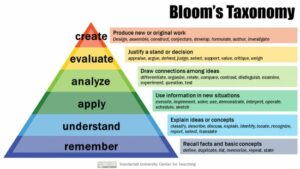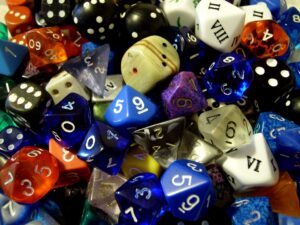
Backward design is an instructional design strategy with three stages. It was developed in the early 2000s by Wiggins and McTighe and has become the leading practice in solid instructional design. The idea is to begin with the end in mind. For more detail, directly from the creators, check out this guide provided by ASCD, written by Wiggins and McTighe: Understanding by Design
Step 1: Identify the desired results.
The first step is to identify and define success in a class. Please review the course’s learning goals and each lesson’s learning objectives. The best way to do this is using Bloom’s Taxonomy.
Bloom’s taxonomy is a framework for categorizing objectives, created by Benjamin Bloom in 1956. The framework has been used to structure objectives, assessments, and activities. The taxonomy is divided into different domains, with the cognitive domains being the most widely known.
The pyramid (shown to the right) is a simple version of the taxonomy, which identifies six levels of cognitive skills. At the bottom, Remember, Understand, and Apply, are considered lower-order thinking. These skills are used to recall information and apply the information in a specific context. The upper levels, Analyze, Evaluate, and Create, are considered higher-order thinking. These skills take the foundational knowledge from the lower levels and begin to extrapolate those ideas into new contexts, including the production of original works, justifying a stance in an argument, or drawing connections between ideas.
Within these layers, there are four dimensions which encompass four types of attitudes, skills, or knowledge (henceforth: ASK) that learners may be expected to acquire or construct. These range from concrete information to more metacognitive abilities. We will talk more about building learning objectives in the next section: Mapping to Success: Steps 1-2.
| Cognitive Dimension | Characteristics |
| Factual |
|
| Conceptual |
|
| Procedural |
|
| Metacognitive |
|
Step 2: Determine Acceptable Evidence
In the next step, begin thinking about assessments. It is beneficial to consider a wide range of assessment methods to ensure students are assessed against the learning goals the instructor wants them to meet within the course. Sometimes, the assessments do not match the learning goals, which can cause frustration for both the instructor and the students. Alignment is critical.
While traditionally, in higher education, exams and papers are the primary forms of assessments, consider new ideas such as these:
Step 3: Plan the Learning Experiences and Instruction
This section is where faculty members will identify instructional strategies and learning activities that align with the assessments and learning objectives. Again, while textbooks and lectures have historically been the strategy of choice, there are many other options to consider. This is where OER can really shine as there are diverse resources available, including but not limited to:

- Games
- Podcasts
- TED Talks and other short videos
- Microlearning
- Mobile learning
- Artificial intelligence
- Extended reality

